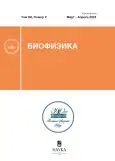Stability of Hypotensive Activity in Freeze-Dried Preparations of Dinitrozyl Iron Complexes with Glutathione (“Oxacom”) throughout the Period of Storage for 15 Years at Ambient Temperature
- Authors: Vanin A.F1, Abramov A.A2, Timoshin A.A2, Lakomkin V.L2, Tkachev N.A1
-
Affiliations:
- N.N. Semenov Federal Research Center for Chemical Physics, Russian Academy of Sciences
- E.I. Chazov National Medical Research Center of Cardiology, Ministry of Health of the Russian Federation
- Issue: Vol 69, No 2 (2024)
- Pages: 349-355
- Section: Articles
- URL: https://journals.rcsi.science/0006-3029/article/view/257585
- DOI: https://doi.org/10.31857/S0006302924020174
- EDN: https://elibrary.ru/OTQFQM
- ID: 257585
Cite item
Full Text
Abstract
Keywords
About the authors
A. F Vanin
N.N. Semenov Federal Research Center for Chemical Physics, Russian Academy of Sciences
Email: vanin.dnic@gmail.com
Moscow, Russia
A. A Abramov
E.I. Chazov National Medical Research Center of Cardiology, Ministry of Health of the Russian FederationMoscow, Russia
A. A Timoshin
E.I. Chazov National Medical Research Center of Cardiology, Ministry of Health of the Russian FederationMoscow, Russia
V. L Lakomkin
E.I. Chazov National Medical Research Center of Cardiology, Ministry of Health of the Russian FederationMoscow, Russia
N. A Tkachev
N.N. Semenov Federal Research Center for Chemical Physics, Russian Academy of SciencesMoscow, Russia
References
- E. I. Chazov, O. V. Rodnenkov, A. V. Zorin, V. L. Lakomkin, V. V. Gramovich, O. N. Vyborov, A. G. Dragnev, А. А. Timoshin, L. I. Buryachkovskaya, A. A. Abramov, V. P. Massenko, E. V. Arzamastsev, V. I. Kapelko, and A. F. Vanin, Hypotensive effect of Oxacom® containing a dinitrosyl iron complex with glutathione: Animal studies and clinical trials on healthy volunteers. Nitric Oxide, 26 (3), 148–156 (2012). doi: 10.1016/j.niox.2012.01.008
- Vanin A. F., Malenkova I. V., and Serezhenkov V. A. Iron catalyzes both decomposition and synthesis of S-nitrosothiols: optical and electron paramagnetic resonance studies. Nitric Oxide, 1, 191–203 (1997).
- Costanzo S., Ménage S., Purrello R., Bonomo R. P., and Fontecave M. Re-Examination of the formation of dinitrosyl–iron complexes during reaction of S-nitrosothiols with Fe (II). Inorg. Chim. Acta, 318 (1–2), 1‒7 (2001). doi: 10.1016/S0020-1693(01)00402-9
- Lo Bello M., Nuccetelli M., Cacurri A. M., Stella L., Parker M. W., Rossjohn J., McKinstry W. J., Mozzi A. F., Federici G., Polizio F., Pedersen J. Z., and Ricci G. Human glutathione transferase P1-1 and nitric oxide carriers. J. Biol. Chem. 276, 42138–42145 (2001). DOI: ь10.1074/jbc.M102344200
- Vanin A. F., Poltorakov A. P., Mikoyan V. D., бKubrina L. N., Burbaev D. S. Polynuclear water-soluble dinitrosyl iron complexes with cysteine or glutathione ligands: Electron paramagnetic resonance and optical studies. Nitric Oxide, 23 (2), 136–149 (2011). doi: 10.1016/j.niox.2010.05.285
- Borodulin R. R., Kubrina L. N., Mikoyan V. D., Poltorakov A. P., Shvydkiy V. O., Burbaev D. Sh., Serezhenkov V. A., Yakhontova E. R., and Vanin A. F. Dinitrosyl iron complexes with glutathione as NO and NO+ donors. Nitric Oxide, 29, 4–16 (2013). doi: 10.1016/j.niox.2012.11.001
- Vanin A. F. and Burbaev D. Sh. Electronic and spatial structures of water-soluble dinitrosyl iron complexes with thiol-containing ligands underlying their ability to act as nitric oxide and nitrosonium ion donors. J. Biophys., 2011, 878236 (2011). doi: 10.1155/2011/878236
- Vanin A. F., Pekshev A. V., Vagapov A. B., Sharapov N. A., Lakomkin V. L., Abramov A. A., Timoshin A. A., and Kapelko V. I. Gaseous nitric oxide and dinitrosyl iron complexes with thiol-containing ligands as potential medicines that can relieve COVID-19. Biophysics, 66 (1), 155–163 (2021). doi: 10.1134/S0006350921010218
- Ванин А. Ф., Микоян В. Д. и Ткачев Н. А. Высвобождение катионов нитрозония из динитрозильных комплексов железа при их распаде под действием анионов супероксида или этилендиаминтетраацетата. Биофизика, 67 (6), 1045–1055 (2022). doi: 10.31857/S0006302922060011
- Ванин А. Ф. Свободно-радикальная природа молекул монооксида азота как фактор, определяющий их превращение в живых организмах в ионы нитрозония. Биофизика, 65 (3), 421–438 (2020). doi: 10.31857/S0006302920030011
- Ванин А. Ф. и Ткачев Н. И. Динитрозильные комплексы железа с тиолсодержащими лигандами как источники универсальных цитотоксинов – катионов нитрозония. Биофизика, 68, 421–434 (2023). doi: 10.31857/S0006302923030018, EDN: FPGKAY
- Vanin A. F., Dinitrosyl iron complexes as a “working form” of nitric oxide in living organisms (Cambridge Scholars Publishing, Cambridge, UK, 2019).
Supplementary files










